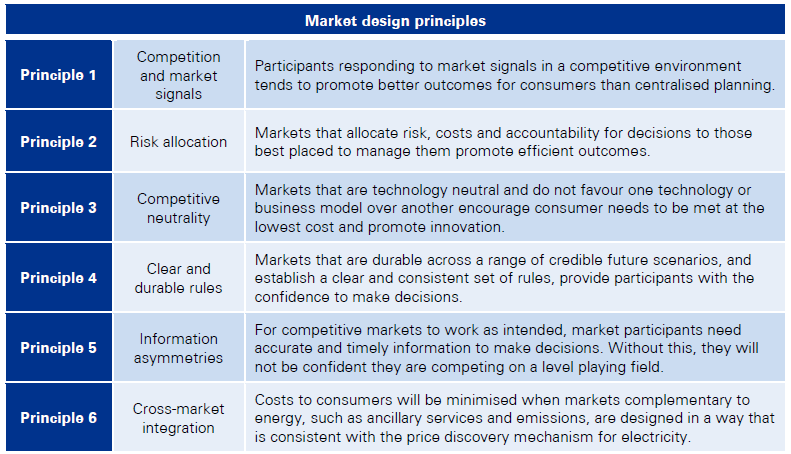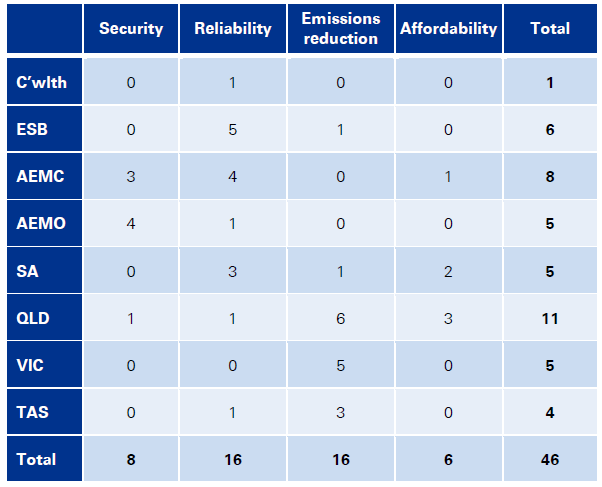New report identifies long-term market design principles
A new KPMG report released today outlines long-term market design principles that can be harnessed to support a sustainable energy future for Australia. The report, "Electricity Market Design Principles", was commissioned by the Australian Energy Council and presents six core market design principles by which proposed reforms can be thoroughly assessed and considered.
The design of the National Electricity Market (NEM) is currently under intense scrutiny. The transformation of the sector is being driven by factors like government emissions policies, such as the Renewable Energy Target, as well as decreasing wind and solar generation costs. Variable renewable energy is creating new challenges for the power system that was designed around dispatchable plant like coal, gas and hydro. At the same time factors such as recent price volatility and concerns over reliability have all combined to result in increased questioning of the current electricity market’s design.
Scrutiny of the existing market is welcomed - the NEM design should evolve to reflect the changing market conditions. The key to successful market improvements will be a well-considered reform process.
The issue is how to evolve the electricity market design to meet the challenge of the scale of the transformation and the level of capital investment required. The $25 billion investment required is highlighted in the KPMG report and was also the focus of an earlier report (What’s involved In Meeting the Energy Investment Challenge?, EnergyInsider 13 April 2018).
“As the electricity system incorporates new technologies with different physical and technical properties, we need to consider how to evolve the market design to reflect these changes and meet the National Electricity Objective,” the report says.
There is a tendency to rush to declare the solution before the problem has been properly defined or considered.
In the report KPMG says its design principles (shown in table 1) "reflect the view that an effectively competitive wholesale electricity market, where participants make investment and operational decisions based on market signals, will provide consumers with the energy services they demand at the lowest possible cost.”
Table 1: Wholesale electricity market design principles

KPMG argues that good outcomes for consumers require good regulatory practice, so how the principles are applied is equally important. “Fundamental electricity market reform requires an integrated and well-structured policy development process.”
The structure begins with first carefully defining the problem. As KPMG notes, prior to considering potential solutions and applying an assessment framework, it is critical to understand fully what problem needs to be solved and whether it is likely to persist. “Not doing so risks solving the wrong problem or a non-existent problem.”
Once the problem is fully defined potential solutions can be explored and, through rigorous assessment, the preferred approach can be identified.
This should be supported by comprehensive stakeholder consultation: “An effective process involves comprehensive stakeholder consultation. Facilitating industry participation in the market reform processes creates a sense of ownership, which is essential for successful outcomes. Ultimately, the outcomes for consumers from market reforms will be enhanced when participants understand, adapt their behaviour and embrace the change.”
There is a risk that without the kind of rigour outlined in the report, rushed proposals for NEM reforms, possibly cherry-picked from other markets, may be implemented.
That in turn would create investor uncertainty and could have unintended consequences. Investors not only look at the market and its rules, but also the reform process. Policy uncertainty affects affordability and KPMG estimates that an increase in the cost of capital by 1 per cent will increase the required annual revenue sought by investors by 10 per cent.
The new report highlights the importance of building confidence in the market framework to underpin the decisions of investors, including electricity customers investing in demand response.
Market Mechanisms Tested
KPMG’s work has identified an effective market design approach and tested a few popular market mechanism proposals against its principles. This is not intended to be an exhaustive assessment to support or dismiss specific ideas, but rather to provide a demonstration of how the process outlined in the report should work.
KPMG’s tested the following approaches against its principles.
- The emissions and reliability guarantees that are part of the National Energy Guarantee
- Capacity market
- Day-ahead market
- Strategic reserve
- Wholesale demand response mechanism
- Inertia and frequency response
- Western Electricity Market constrained access.
The assessment of each of these approaches is outlined in the main report.
Conclusion
KPMG’s market design principles report highlights the complexity of the policy landscape. By its count there are a total of 46 policies or initiatives being considered with 16 primarily focused on reliability, eight on security, 16 on emissions reduction and six on affordability (table 2).
Table 2: Count of energy policy proposals by objective and organisation

Source: KPMG (ESB = Energy Security Board, AEMC = Australian Energy Market Commission, AEMO = Australian Energy Market Operator)
It also offers an approach and principles to identify and support the best way forward – in this way it acts both as a valuable marker and a roadmap for the reform process.
A copy of the report can be found here
A copy of the Executive Summary is available here
Related Analysis
Retail protection reviews – A view from the frontline
The Australian Energy Regulator (AER) and the Essential Services Commission (ESC) have released separate papers to review and consult on changes to their respective regulation around payment difficulty. Many elements of the proposed changes focus on the interactions between an energy retailer’s call-centre and their hardship customers, we visited one of these call centres to understand how these frameworks are implemented in practice. Drawing on this experience, we take a look at the reviews that are underway.
Data Centres and Energy Demand – What’s Needed?
The growth in data centres brings with it increased energy demands and as a result the use of power has become the number one issue for their operators globally. Australia is seen as a country that will continue to see growth in data centres and Morgan Stanley Research has taken a detailed look at both the anticipated growth in data centres in Australia and what it might mean for our grid. We take a closer look.
Green certification key to Government’s climate ambitions
The energy transition is creating surging corporate demand, both domestically and internationally, for renewable electricity. But with growing scrutiny towards greenwashing, it is critical all green electricity claims are verifiable and credible. The Federal Government has designed a policy to perform this function but in recent months the timing of its implementation has come under some doubt. We take a closer look.
Send an email with your question or comment, and include your name and a short message and we'll get back to you shortly.



